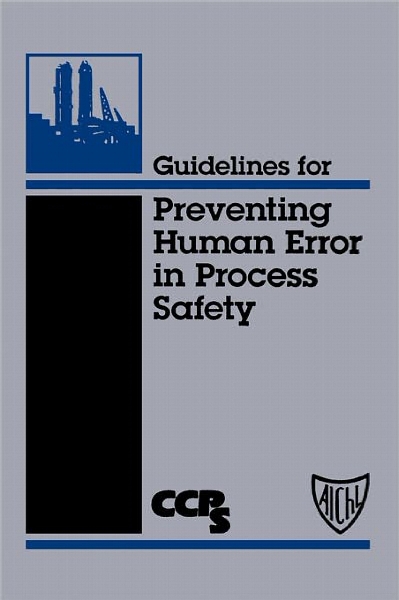Guidelines for preventing human error in process safety
- نوع فایل : کتاب
- زبان : انگلیسی
- مؤلف : American Institute of Chemical Engineers. Center for Chemical Process Safety.
- ناشر : New York, NY : Center for Chemical Process Safety of the American Institute of Chemical Engineers
- چاپ و سال / کشور: 1994
- شابک / ISBN : 9781591245834
Description
Contents List of Figures and Tables ......................................................... ix Preface ...................................................................................... xii Glossary and Acronyms ............................................................ xvii 1. Introduction: The Role of Human Error in Chemical Process Safety .................................................. 1 1.1 Introduction ............................................................................ 1 1.2 The Role of Human Error in System Accidents ...................... 4 1.3 Why Is Human Error Neglected in the CPI? ........................... 10 1.4 Benefits of Improved Human Performance ............................ 10 1.5 The Traditional and System-Induced Error Approach ............ 12 1.6 A Demand-Resource Mismatch View of Error ....................... 15 1.7 A Case Study Illustrating the System-Induced Error Approach ................................................................................ 17 1.8 From Theory to Practice ......................................................... 19 1.9 Appendix: Case Studies ......................................................... 22 2. Understanding Human Performance and Error .............. 39 2.1 Purpose of the Chapter .......................................................... 39 2.2 Concepts of Human Error ...................................................... 39 2.3 An Overview of the Four Perspectives on Human Error ....................................................................................... 44 2.4 The Traditional Safety Engineering Approach to Accidents and Human Error ................................................... 47 vi Contents 2.5 The Human Factors Engineering and Ergonomics Approach (HF/E) .................................................................... 55 2.6 The Cognitive Engineering Perspective ................................. 67 2.7 The Sociotechnical Perspective ............................................. 85 2.8 Summary ................................................................................ 93 2.9 Appendix 2A: Process Plant Example of the Stepladder Model ................................................................... 94 2.10 Appendix 2B: Flowcharts for Using the Rasmussen Sequential Model for Incident Analysis (Petersen, 1985) ...................................................................................... 96 2.11 Appendix 2C: Case Study Illustrating the Use of the Sequential Model ................................................................... 100 3. Factors Affecting Human Performance in the Chemical Industry ............................................................. 103 3.1 Introduction ............................................................................ 103 3.2 Applications of Performance-Influencing Factors ................... 105 3.3 A Classification Structure for Performance-Influencing Factors ................................................................................... 107 3.4 Operating Environment .......................................................... 109 3.5 Task Characteristics ............................................................... 120 3.6 Operator Characteristics ........................................................ 133 3.7 Organizational and Social Factors ......................................... 142 3.8 Interaction of Performance-Influencing Factors ..................... 148 3.9 Variability of Human Performance during Normal and Emergency Situations ............................................................ 149 3.10 Summary ................................................................................ 152 4. Analytical Methods for Predicting and Reducing Human Error ...................................................................... 153 4.1 Introduction ............................................................................ 153 Contents vii 4.2 Data Acquisition Techniques .................................................. 154 4.3 Task Analysis ......................................................................... 161 4.4 Human Error Analysis Techniques ......................................... 189 4.5 Ergonomics Checklists ........................................................... 196 4.6 Summary ................................................................................ 199 5. Qualitative and Quantitative Prediction of Human Error in Risk Assessment ................................................. 201 5.1 Introduction ............................................................................ 201 5.2 The Role of Human Reliability in Risk Assessment ............... 202 5.3 System for Predictive Error Analysis and Reduction (SPEAR) ................................................................................. 207 5.4 Critical Task Identification and Screening Analysis ................ 209 5.5 Qualitative Human Error Analysis .......................................... 211 5.6 Representation ....................................................................... 219 5.7 Quantification ......................................................................... 222 5.8 Summary ................................................................................ 240 5.9 Appendix 5A: Influence Diagram Calculations ....................... 241 6. Data Collection and Incident Analysis Methods ............. 247 6.1 Introduction ............................................................................ 247 6.2 An Overview of Data Collection Systems ............................... 249 6.3 Types of Data Collection Systems ......................................... 251 6.4 Organizational and Cultural Aspects of Data Collection ............................................................................... 255 6.5 Types of Data Collected ......................................................... 260 6.6 Methods of Data Collection, Storage, and Retrieval .............. 266 6.7 Data Interpretation ................................................................. 268 6.8 Root Cause Analysis Techniques .......................................... 270 6.9 Implementing and Monitoring the Effectiveness of Error Reduction Measures ..................................................... 287 viii Contents 6.10 Setting Up a Data Collection System in a Chemical Plant ....................................................................................... 288 6.11 Summary ................................................................................ 290 7. Case Studies ...................................................................... 291 7.1 Introduction ............................................................................ 291 7.2 Case Study 1: Incident Analysis of Hydrocarbon Leak from Pipe ................................................................................ 292 7.3 Case Study 2: Incident Investigation: Mischarging of Solvent in a Batch Plant ......................................................... 307 7.4 Case Study 3: Design of Standard Operating Procedures for Task in Case Study 2 .................................... 314 7.5 Case Study 4: Design of Visual Display Units for Computer-Controlled Plant ..................................................... 325 7.6 Case Study 5: Audit of Offshore Emergency Blowdown Operations ............................................................ 334 8. Implementing an Integrated Error and Process Safety Management System at the Plant ......................... 345 8.1 Introduction ............................................................................ 345 8.2 Managing Human Error by Design ......................................... 346 8.3 Setting Up an Error Management System in an Existing Plant ......................................................................... 357 8.4 Summary ................................................................................ 363 References ............................................................................... 365 Bibliography ............................................................................. 376 Index ......................................................................................... 379


